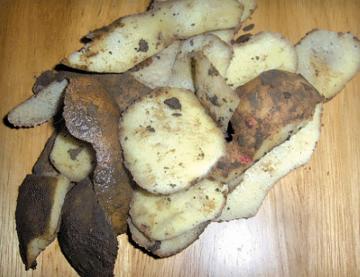
Potato waste
India is the third largest potato producer after China and Russian Federation, in the world. In India, potato production was estimated about 34391 thousand tones in 2010 (FAO). The amount of waste and by- product of potato industry is estimated to be around 12-20% of their total production. Potato processing generates waste in the form of peels, pulp and rejects. Potato peels, pulp and unpmarketable potatoes can be processed and incorporated into animal feed formulations. Thus the attempts to utilize the industrial wastes (potato peels, pulps and starch) and waste potatoes for animal feeding will provide additional feed options for the livestock and make potato growing and processing more economical.
Nutritional value
Potato waste is an excellent energy source for feedlot cattle. It has energy value similar to corn and barley while being low in protein and calcium. Potato waste meal produced by drying and grinding whole potatoes, potato pulp and peelings and discarded potato chips contain 7.6% CP, 7.0% EE, 4% CF and 4% ash (Hulfan et al. 1982).
Inclusion
Large amounts of discarded potato can be fed to beef cattle after cattle have been adapted to such rations. The biggest problem that has managed with potato waste is the water, as raw potatoes contain about 80% water. Animal feed pellets can be prepared from unmarketable potato, barley and maize. Feed pellets were prepared by incorporating 10-20% unmarketable potatoes as an ingredient.
